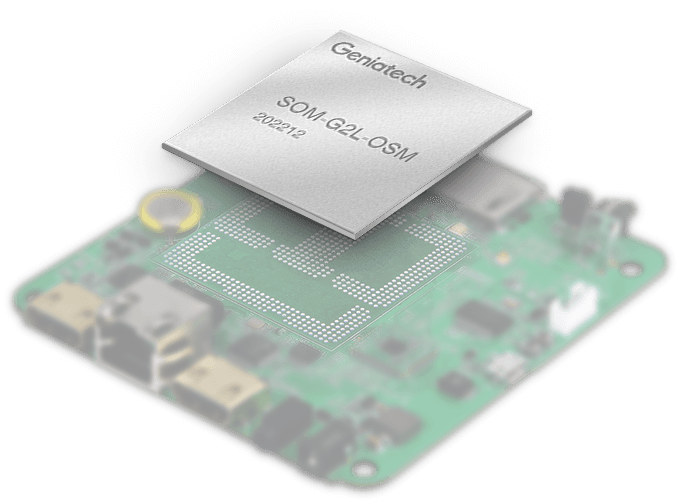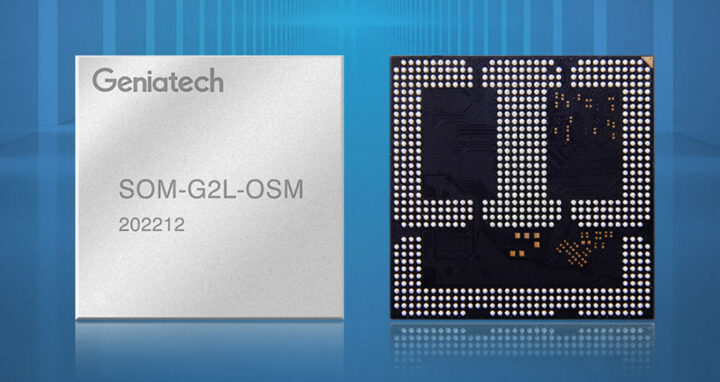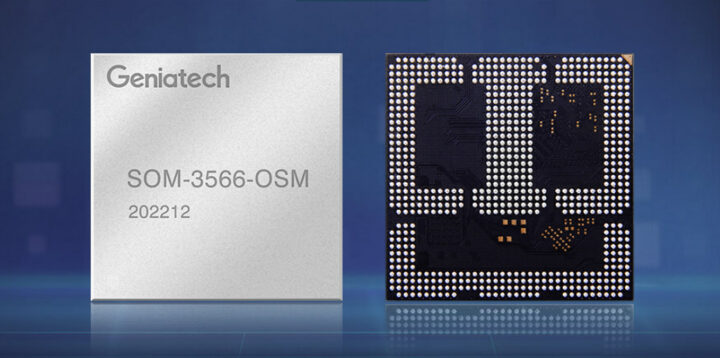Geniatech has introduced LGA system-on-modules compliant with the SGET OSM (Open Standard Module) Size-L standard and designed to be soldered directly on the carrier board. Two models have been launched with the SOM-G2L-OSM equipped with Renesas RZ/G2L Arm Cortex-A55/M33 processor, and the SoM-3566-OSM powered by a Rockchip RK3566 quad-core Cortex-A55 SoC.
SOM-G2L-OSM module
Specifications:
- SoC – Renesas RZ/G2L dual-core Cortex-A55 processor, Cortex-M33 real-time core, Arm Mali-G31 GPU, H.264 video encoder/decoder
- System Memory – 1GB RAM (2GB/4GB optional)
- Storage – 8GB eMMC flash (16GB/32GB optional)
- 662 contacts with
- Display – 1x MIPI DSI, 1x RGB
- Camera – 1x MIPI CSI
- Audio – I2S
- Networking – 2x Gigabit Ethernet
- USB – 1x USB OTG 2.0, 1x USB 2.0 host
- Serial – 2x CAN bus
- SDIO 3.0
- Low-speed I/Os – 5x UART including debug, 2x I2C, 3x SPI, 3x PWM, 16x GPIO, 2x ADC
- Dimensions – 45 x 45 mm (OSM Size-L form factor)
- Temperature Range – -40°C to +85°C

The company talks about Linux support without detail and says it is suitable for industrial control, human-machine interfaces (HMI), gateways, edge computing, and more. But from our initial article about the Renesas RZ/G2L family we know those are supported by a Verified Linux Package (VLP) featuring the Civil Infrastructure Platform (CIP), an industrial-grade Linux distribution offering guaranteed support and security maintenance for more than 10 years.
Pricing is not available, and you’d have to ask for a “volume quote” to get pricing information. More details may be found on the product page.
Geniatech SoM-3566-OSM module
Specifications:
- SoC – Rockchip RK3566 quad-core Cortex-A55 processor @ up to 1.8 GHz with Arm Mali-G52 2EE GPU, 1 TOPS NPU, 4Kp60 MPEG4/H.264/VP9 video decoding and 1080p100 MPEG4/H.264 video encoding
- System Memory – 2GB LPDDR4 (optional 1GB, 4GB and 8GB)
- Storage – 8GB eMMC flash (option from 8GB to 128GB)
- 662 contacts with
- Video output – HDMI 2.0, eDP, LVDS, MIPI DSI
- Camera – 4-lane MIPI CSI, CIF/DVP
- Audio – 1x I2S
- Networking – 1x RGMII (Gigabit Ethernet)
- USB – 1x USB 3.0, 2x USB 2.0, 1x USB OTG
- PCIe – 1x PCIe 2.1
- Low speed I/Os – 3x UART, 4x I2C, 1x SPI, 1x FSPI (Flexible SPI), 3x PWM, 2x ADC, 24x GPIO
- 2x SDIO
- JTAG
- Supply voltage – 5V
- Dimension – 45x45mm (OSM Size-L form factor)
- Temperature Range
- Consumer – 0°C to 70°C
- Industrial – -20°C to 85°C (specs) or -40°C to +85°C (illustrations). Note the -20°C to 85°C temperature range is usually referred to as “commercial grade” as opposed to “industrial grade” for -40°C to +85°C, at least according to some Rockchip documents.
- RoHS and Reach compliant
Geniatech provides Debian and Android images for the OSM module, as well as support for Buildroot and the Yocto Project build systems. Some of the typical use cases for the module include audio-visual entertainment, smart NVR, cloud terminal, IoT gateway, industrial control, edge computing, access control with facial recognition, vehicle dashboard, digital signage, AIoT, etc…
You can get more information and/or request pricing information on the product page.

Jean-Luc started CNX Software in 2010 as a part-time endeavor, before quitting his job as a software engineering manager, and starting to write daily news, and reviews full time later in 2011.
Support CNX Software! Donate via cryptocurrencies, become a Patron on Patreon, or purchase goods on Amazon or Aliexpress. We also use affiliate links in articles to earn commissions if you make a purchase after clicking on those links.







I’m not really sure what market these are for. In my experience, the reason you use a SoM (rather than doing it all yourself) is to avoid having an expensive PCB stack up and dealing with BGAs, so you pay the vendor a profit margin in return for that convenience. In this case you still have BGAs, and looks like you also need blind microvias for the fanout?
Ok, I stand corrected, you can fit a 0.4mm via in between the balls. But you may still need to plate them shut and/or use blind and buried vias in order to reasonably route the board.
This module will come with pre-designed layout from the vendor. Maybe CNX can get a picture of it. You won’t need to design it yourself, they will show you the optimal way to access all of the pins.
Now, that’s a good idea! You pay (a bit) more to get A LOT of convenience and also an innate upgrade path. Technically, you should be able to use the same board for at least 20 years, even if this particular system goes eol. Should save a lot of money in the long run
It’s definitely a viable business because Octavo Systems has been doing it for years (with TI AM335x and ST STM32MP1). One thing you forget is how many components (e.g. hundreds of passives) are required by a modern MPU, some of which require careful PCB layout (e.g. DDR).
A careful and wide BGA layout makes breaking out the traces much easier – and it’s easier to do when you need fewer balls (e.g. no external DDR traces).
And the RK3588 Development board.